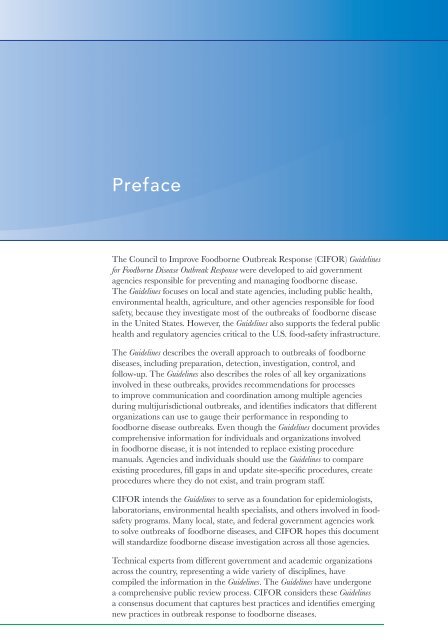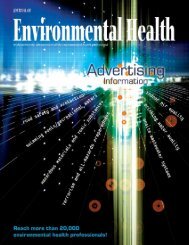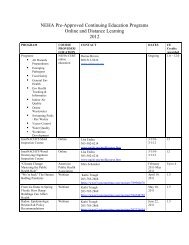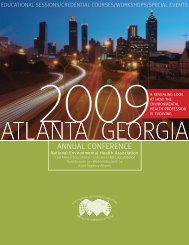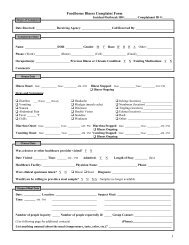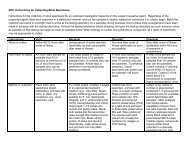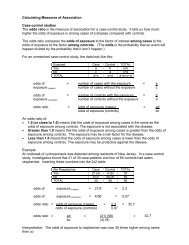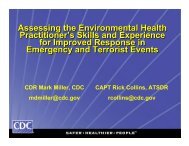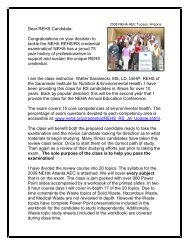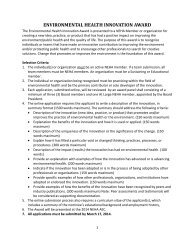Guidelines For Foodborne Disease outbreak Response.pdf - CIFOR
Guidelines For Foodborne Disease outbreak Response.pdf - CIFOR
Guidelines For Foodborne Disease outbreak Response.pdf - CIFOR
You also want an ePaper? Increase the reach of your titles
YUMPU automatically turns print PDFs into web optimized ePapers that Google loves.
Preface<br />
The Council to Improve <strong>Foodborne</strong> Outbreak <strong>Response</strong> (<strong>CIFOR</strong>) <strong>Guidelines</strong><br />
for <strong>Foodborne</strong> <strong>Disease</strong> Outbreak <strong>Response</strong> were developed to aid government<br />
agencies responsible for preventing and managing foodborne disease.<br />
The <strong>Guidelines</strong> focuses on local and state agencies, including public health,<br />
environmental health, agriculture, and other agencies responsible for food<br />
safety, because they investigate most of the <strong>outbreak</strong>s of foodborne disease<br />
in the United States. However, the <strong>Guidelines</strong> also supports the federal public<br />
health and regulatory agencies critical to the U.S. food-safety infrastructure.<br />
The <strong>Guidelines</strong> describes the overall approach to <strong>outbreak</strong>s of foodborne<br />
diseases, including preparation, detection, investigation, control, and<br />
follow-up. The <strong>Guidelines</strong> also describes the roles of all key organizations<br />
involved in these <strong>outbreak</strong>s, provides recommendations for processes<br />
to improve communication and coordination among multiple agencies<br />
during multijurisdictional <strong>outbreak</strong>s, and identifies indicators that different<br />
organizations can use to gauge their performance in responding to<br />
foodborne disease <strong>outbreak</strong>s. Even though the <strong>Guidelines</strong> document provides<br />
comprehensive information for individuals and organizations involved<br />
in foodborne disease, it is not intended to replace existing procedure<br />
manuals. Agencies and individuals should use the <strong>Guidelines</strong> to compare<br />
existing procedures, fill gaps in and update site-specific procedures, create<br />
procedures where they do not exist, and train program staff.<br />
<strong>CIFOR</strong> intends the <strong>Guidelines</strong> to serve as a foundation for epidemiologists,<br />
laboratorians, environmental health specialists, and others involved in foodsafety<br />
programs. Many local, state, and federal government agencies work<br />
to solve <strong>outbreak</strong>s of foodborne diseases, and <strong>CIFOR</strong> hopes this document<br />
will standardize foodborne disease investigation across all those agencies.<br />
Technical experts from different government and academic organizations<br />
across the country, representing a wide variety of disciplines, have<br />
compiled the information in the <strong>Guidelines</strong>. The <strong>Guidelines</strong> have undergone<br />
a comprehensive public review process. <strong>CIFOR</strong> considers these <strong>Guidelines</strong><br />
a consensus document that captures best practices and identifies emerging<br />
new practices in <strong>outbreak</strong> response to foodborne diseases.


